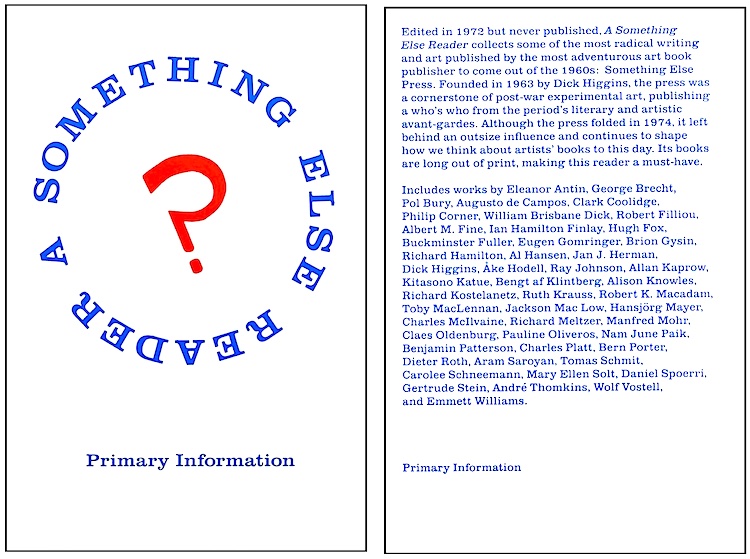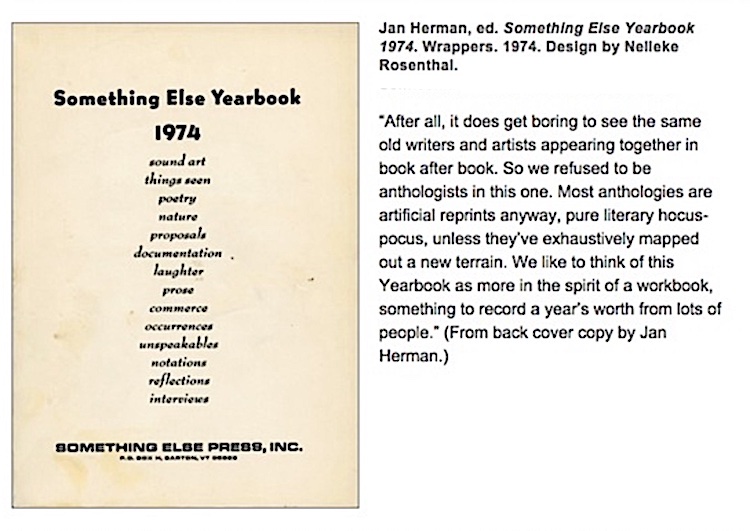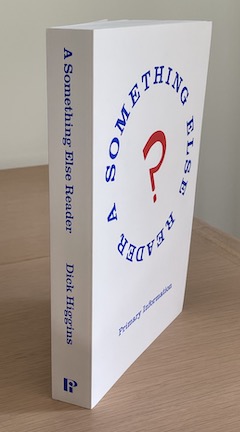“A Something Else Reader is a previously unpublished anthology edited by Dick Higgins in 1972 to celebrate Something Else Press, the publishing house he founded in 1963, and to showcase Fluxus and other experimental artistic and literary forms. … He assembled the table of contents and an introduction into a proposal, which went into his archive, where it was found by scholar and curator Alice Centamore, who compiled the works and assembled it.”
— Primary Information
Hats off to Alice for the discovery, and the execution! Although Dick refers in his introduction to “my good friend Jan Jacob Herman” and “now my colleague, as editor” of SEP, he never told me about the proposal, and I knew nothing of it until these many years later. Nor did I know that he had selected a piece of mine from Fantastic Architecture for the anthology, alongside works by artists well out of my league: Pol Bury, Claes Olderburg, Buckminster Fuller, Alison Knowles, Richard Hamilton, and Wolf Vostell.

Clearly, Dick could be as private and compartmentalized about his projects as he was imaginative. It also hints at why during my tenure he was so eager to have me pull together the Something Else Yearbook 1974, a volume that does for that year what he intended his Reader to do for the history of the press.

Primary Information, as publisher of A Something Else Reader, points out that this volume “collects some of the most radical writing and art published by the most adventurous art book publisher to come out of the 1960s. … [SEP] was a cornerstone of post-war experimental art, publishing a who’s who from the period’s literary and artistic avant-garde [and] left behind an outsize influence [that] continues to shape how we think about artists’ books to this day. Its books are long out of print, making this read a must-have.”
Furthermore:
“The publication features selections from Claes Oldenburg’s Store Days, John Cage’s Notations, An Anthology of Concrete Poetry, Breakthrough Fictioneers, Jackson Mac Low’s Stanzas for Iris Lezak, Gertrude Stein’s Matisse Picasso and Gertrude Stein, Bern Porter’s I’ve Left, Wolf Vostell’s Dé-coll/age Happenings, Al Hansen’s A Primer of Happenings & Time/Space Art, and other projects for the page by Robert Filliou, Alison Knowles, Nam June Paik, Philip Corner, Daniel Spoerri, André Thomkins, and Richard Meltzer, among others. An annotated checklist assembled by Hugh Fox and Higgins’s unpublished introduction are also included.
“Perhaps no other publisher in the 1960s influenced artists’ books more than Something Else Press. Higgins had a firm vision that radical art could be housed in book form and distributed throughout the world and he worked endlessly to cultivate new works that challenged conventional notions of both contemporary art and books. He sought to distribute these titles far and wide, even hiring door-to-door salesmen to pitch titles like Jackson Mac Low’s Stanzas for Iris Lezak and Emmett Williams’s An Anthology of Concrete Poetry. While other presses created extraordinary publications, none were able to achieve the breadth of titles and artists like Higgins, who successfully ran Something Else Press until 1974 in a manner that resembled a more traditional paperback publisher.”
Amen to all that.






Jan,
This is a beautiful post for more reasons than I have time to list.
However, learning that Dick Higgins created the word “intermedia” is profoundly enlightening!
The word became part of my vocabulary around 1965-66 when the art communities in Vancouver (British Columbia) decided that the city needed a place where all the new communications and recording media could become explored by all artists, including writers/poets, painters, sculptors, musicians, actors, actresses and filmmakers.
The word “intermedia” had a place in most conversations about the arts but no one, including me, as far as I know, had any idea where the word *intermedia* came from.
It seemed to just be in the conversational air.
Such a place – named INTERMEDIA – came into being and was an important resource for the arts in the city for about seven years.
Knowing now that Dick Higgins coined the term has been a wonderful way to experience Halloween, 2022!
So, Thank You!
Gary — Your thoughts, as usual generous, and much appreciated. — Jan
Think of you often, Jan, and I’m glad for you that Hidden Treasures celebrating your contributions and history are coming your way. Hope this finds you healthy and well & swimming every day (although not in the East River!).
Gail
Thanks for the heads up, Jan. Very excited to read some of the essays. Ordering it right now!
Warmest,
Helen
There are two great pieces in the Reader by Nam June Paik—:”Cybernated art” and “Utopian Laser Station”—both of which must interest you.
Hi Jan,
I’m grateful to you for this post. You have the original background.
Warm regards,
Alison
one of the most pleasing things about A Something Else Reader, apart from the contents, is the feel of the covers, front and back. you can actually feel the letters. they’ve been stamped into the paper, as though embossed like some kind of super letterpress printing process. waiting to hear what exactly the technique was.
the technique turns out to be “foil stamped.” never heard of it. on further inquiry have been told it’s “thermography.,” a raised plastic process that was commonly used for (cheap) business cards. whatever it’s called, though, it’s been put to use here, beautifully.
i take that back. Foil stamped it is. And nothing to do with thermography.